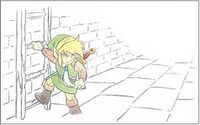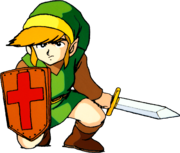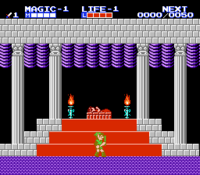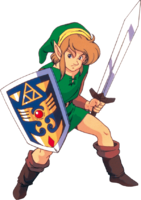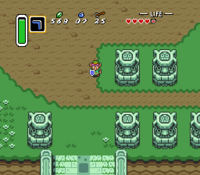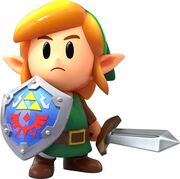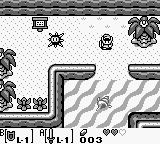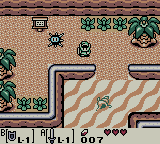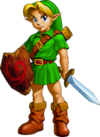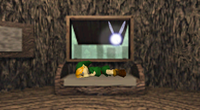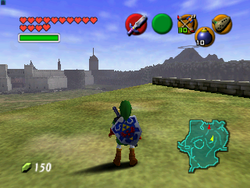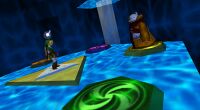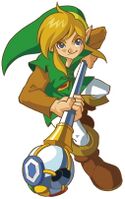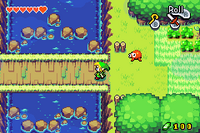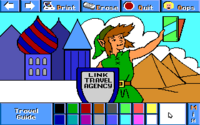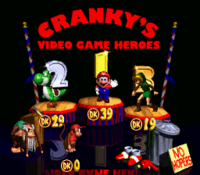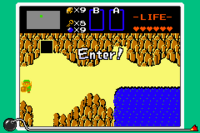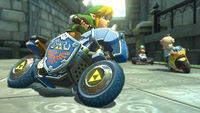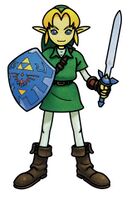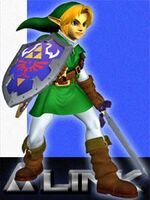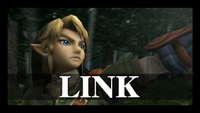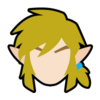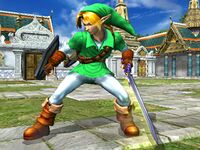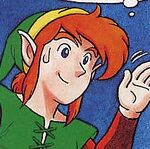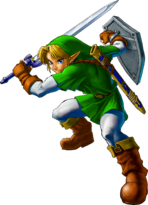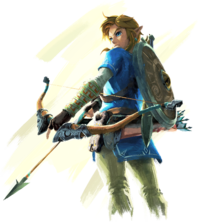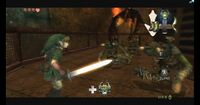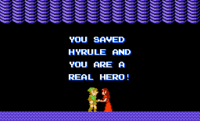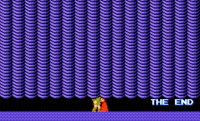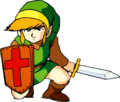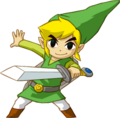Welcome to the new Mariopedia!
Link
| Link | |
|---|---|
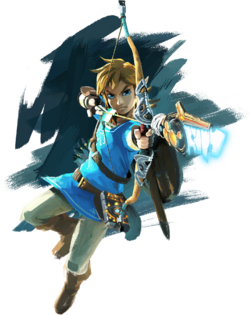 The Legend of Zelda: Breath of the Wild artwork | |
| General information | |
| Species | Hylian |
| Counterparts | Ravio Shadow Link Toon Link Young Link |
| Other forms | Deku Link Fairy Fierce Deity Link Giant Link Goron Link Wolf Link Zora Link |
| Gender | Male |
| Homeland | Hyrule (most appearances) Great Sea (The Wind Waker) New Hyrule (Spirit Tracks) The Sky (Skyward Sword) |
| Hometown | Hyrule Castle (various media) Kokiri Forest (Ocarina of Time, as a child) Outset Island (The Wind Waker) Ordon Village (Twilight Princess) Aboda Village (Spirit Tracks) Skyloft (Skyward Sword) Hateno Village (Breath of the Wild, after completing "Hylian Homeowner") |
| Affiliations | Royal Family of Hyrule (several appearances) Kokiri (Ocarina of Time) Gorons (since Ocarina of Time) Gerudo (occasionally) Bombers Secret Society of Justice (Majora's Mask) Seeker's Guild (Four Swords Adventures) Knights of Skyloft (Skyward Sword) Big Bad Bazz Brigade (Breath of the Wild) Champions (Breath of the Wild, Age of Calmity) Knights of Hyrule (Breath of the Wild) |
| Portrayed by | Jonathan Potts (cartoon) Jeffrey Rath (CD-i games) See more... |
| Appearances | |
| First appearance | The Legend of Zelda (1986) The Super Mario Bros. Super Show! (1989, Mario franchise) |
| Latest appearance | Game & Watch: The Legend of Zelda (2021, overall) WarioWare: Get It Together! (2021, Mario franchise) |
Link is the main protagonist of The Legend of Zelda franchise, having debuted in the game of the same name. He is the main playable character in every main series title. Link usually depicted as wearing a green tunic and a sword and a shield for his main weapon. Many incarnations of Link, as well as Princess Zelda, appear throughout the series. Every incarnation of Link is part of the Hylian race, and in the games, he is either a child, a teenager, or a young adult. The relation between some of Link's incarnations are only explained in some games, with sources such as The Legend of Zelda: Hyrule Historia creating broader maps.
All of Link's adventures involve him trying to stop a force of evil, usually the franchise's main antagonist, Ganon. The game is usually set in Hyrule, where Link travels around an expansive overworld and endures trials within dungeons, each having a boss at the end. As he progresses in his journey, Link obtains more items and weapons that help him along the way. At the final boss, who is usually Ganon, Link is usually required to use a legendary weapon (such as the Master Sword or Silver Arrows). Sometimes Link has to rescue a damsel in distress, such as Zelda.
One of Link's main attributes is his courage. In many games, a mark of the Triforce appears on Link's hand, showing that he bears the Triforce of Courage.
In the Mario franchise, Link has made a cameo appearance in several titles, and has had some playable appearances, most often in the The Legend of Zelda-themed microgames in the WarioWare series. Link is also a playable fighter in every installment of the Super Smash Bros. series.
Creation
When The Legend of Zelda was being developed, Nintendo wanted the main character to be identifiable by players, like Mario, largely due to the technical limitations of the Famicom. Shigeru Miyamoto wanted Link to carry around a large sword and shield, but at the same time have players distinguish the on-screen sprite of Link from the sword and shield that he carries. Nintendo thought of using a long hat and big ears, which reminded them of fairy-like characters, so they went in the direction of an elf. As a big Disney fan, Miyamoto first thought of Peter Pan in regard to the design of a boy with pointed ears. Miyamoto thought it would be perfect to use Peter Pan's green, which they were able to use within the Famicom's color limitations.
Originally for the first The Legend of Zelda, the Triforce would have been made up of electronic chips instead of fragments. With the chips, Link would have traveled between the past and the future; his name directly states how he would have been a link between the time periods.[1] Eiji Aonuma further explains that Link's name was for the player to connect with the character.[2]
Original concept artwork showed Link holding a sword in his right hand, but in the game itself, Link holds it in his left hand. This change was done to aid in the creation of sprite art and the in-game layouts.[3]
Game history
The Legend of Zelda series
The Legend of Zelda
In the backstory for The Legend of Zelda, Ganon and his minions invade the Kingdom of Hyrule. Princess Zelda sends her nursemaid Impa to find someone with the courage to save Hyrule. During her travels, Impa gets cornered by Ganon's minions. Link suddenly appears and rescues her from Ganon's minions. Impa explains about Ganon's invasion of Hyrule. Link goes on an adventure to rescue Zelda and the Kingdom of Hyrule.
Link goes on an adventure to recover the eight fragments of the Triforce of Wisdom, which he must obtain to gain the strength to fight Ganon in Death Mountain. From the overworld, Link fights enemies and travels into the labyrinths. At the end of each labyrinth, Link must fight a boss, and by defeating it, he obtains one of the Triforce fragments.
After recovering every unit of the Triforce of Wisdom, Link goes to Death Mountain in a final showdown against Ganon. Link shoots a Silver Arrow at Ganon and defeats him. He recovers the Triforce of Power from Ganon's ashes and rescues Zelda. The game ends with Link and Zelda holding up each of the Triforces.
Zelda II: The Adventure of Link
Link makes his second appearance in Zelda II: The Adventure of Link. The game takes place many seasons after Ganon was defeated in the first game. Prior to the events of Zelda II: The Adventure of Link, Ganon's minions waited for Ganon to return. Ganon could only be resurrected if Link was sacrificed and his blood was sprinkled over Ganon. Link stayed in Hyrule, helping to work toward its restoration.
One day, as Link was approaching his 16th birthday, he saw that the back of his left hand had a birthmark resembling the crest of Hyrule. He visited Impa, who was surprised to see his birthmark. Impa took Link to the North Castle and up to a locked, unopenable door. By pressing the back of Link's left hand on the door, Impa was able to open it. Inside the room, Princess Zelda lay inside the room under a permanent slumber; she is a different Zelda from the one in the first game.
Impa explained how Zelda fell into a permanent slumber, and she gave him six crystals and a scroll with the Hyrule crest, both of which are hereditary items in Impa's family. Link opened the scroll, which was written in an ancient script. Although Link never saw the letters before, he could read the scroll as if it was talking to him. Link learned about the legend of the Triforce and also the crest on his hand: the King of Hyrule could not find a person worthy of using the Triforce, so he hid the Triforce of Courage and cast a spell on Hyrule so that only a worthy person would gain the crest, based on their upbringing, experience, and becoming of a certain age. After Link reads the scroll, Impa tells him that the complete Triforce is needed to break the spell on Zelda. With his magical sword and magical shield equipped, Link goes on an adventure to reverse the spell put on Zelda.
In the game, Link starts out in the North Castle. The gameplay differs from the first game because the player most often controls Link in sidescrolling areas. The land map is the only area where Link is seen from a top-down perspective while towns, dungeons, and interior locations are side-scrolling. It is the only game where Link gains experience and extra lives. He can talk to town folk to gain hints and information during his adventure.
To awaken Princess Zelda, Link must return a crystal to each of the six palaces. A guardian is at the end of each one, and by defeating it, Link can return the crystal into the palace. After completing all six palaces, Link can enter the Great Palace. Unlike the six earlier palaces, the Great Palace has two guardians which Link battles separately: the Thunderbird and then his own shadow. Link defeats both bosses, recovers the Triforce of Courage and then returns to Zelda in the North Castle. With all three pieces of the Triforce united, Link successfully wishes for Princess Zelda to be awakened. His adventure ends with him presumably kissing Zelda behind the curtain.
The Legend of Zelda: A Link to the Past
In The Legend of Zelda: A Link to the Past, Link lives in a house to the south of Hyrule Castle. One night, Link hears a telepathic message from Princess Zelda, the last one remaining of the seven maidens, that she is imprisoned under Hyrule Castle. After waking up, Link leaves his home and goes to Hyrule Castle, quietly following after his uncle, who also went to rescue Zelda. At the castle, Link receives another message from Zelda, who directs him to a hidden entrance into the castle's first basement floor. There, Link finds his uncle, who was mortally injured from battle. Just before dying, Link's uncle gives a sword and shield to Link and teaches the Spin Attack to him. After continuing down a few more floors, Link battles a Ball and Chain Trooper and rescues Zelda from her cell. They take a Secret Passage to the Sanctuary, where they meet the Loyal Sage.
At the Sanctuary, the Loyal Sage explains to Link about Agahnim, an evil wizard who usurped the throne and is trying to break a seal keeping Ganon in the Dark World. The Loyal Sage explains that the Master Sword is the only object that can defeat Agahnim. Link cannot wield the Master Sword until he has obtained the three Pendants of Virtue, proving himself worthy.
Shortly before the Eastern Palace, Link meets an elder named Sahasrahla in a temple. With his help, Link eventually obtains all three Pendants of Virtue. Link travels into the Lost Woods and takes the pendants to the Master Sword, enabling him to pull the Master Sword from its pedestal. Link then receives a message from Sahasrahla, asking him to return to Hyrule Castle and break the surrounding barrier. Link is contacted again by Zelda, who tells him that soldiers have attacked the Sanctuary. When Link arrives, he learns from the dying Loyal Sage that Zelda was kidnapped and taken to the Hyrule Castle Tower. Link arrives at the tower too late to stop Agahnim from sending Zelda to the Dark World. After being defeated in the ensuing battle, Agahnim also sends Link into the Dark World.
To stop Ganon and save Hyrule, Link must rescue the seven maidens, including Princess Zelda, from each of the seven dungeons in the Dark World. After rescuing the maidens, they use their power to break the barrier around Ganon's Tower, where Link battles Agahnim again. After Link defeats Agahnim again, Ganon rises from Agahnim's body, transforms into a bat, and flies away. Link goes after Ganon, finally confronting him inside the central pyramid of the Dark World. After defeating Ganon again, Link finds the Triforce and touches it, wishing for Hyrule to return to normal. With peace restored to Hyrule and his uncle restored to life, Link returns the Master Sword into its pedestal in the Lost Woods.
The Legend of Zelda: Link's Awakening
In The Legend of Zelda: Link's Awakening, after defeating Ganon in the previous game, Link goes on a journey to improve his skills to better withstand possible threats against Hyrule. After a few months of training, Link felt ready to return to Hyrule, so he got on a sailboat and took a voyage back to Hyrule.
Link travels across the Great Hyrulean Sea, he is caught in a big thunderstorm. Link's ship is hit by a squall and then a bolt of lighting, breaking it to pieces. Link drifts away unconsciously with the remains of his ship and eventually washes ashore on Koholint Island. A young woman named Marin finds Link and takes him to her house to recover.
At the start of the game, Link wakes up in Marin's house. Link recovers his shield from Tarin and goes to look for his missing sword. Link finds his sword on Toronbo Shores, the place where he had been washed ashore. Link is greeted by an owl who explains that he cannot leave Koholint Island unless he awakens the Wind Fish from its eternal sleep. To awaken the Wind Fish, Link must collect all eight Instruments of the Sirens, one in each dungeon.
When Link completes the fifth dungeon, Catfish's Maw, the owl instructs him to go to the Ancient Ruins before going to the sixth dungeon itself, Face Shrine. At the Ancient Ruins, Link learns the truth about Koholint Island—the whole island is only an illusion part of the Wind Fish's dream. The Nightmares want control over Koholint Island, so they attempt to dissaude Link from waking up the Wind Fish, which would cause the whole island and its inhabitants to cease to exist.
Once Link obtains all eight Instruments of the Sirens, he returns to the Wind Fish's Egg on Mt. Tamaranch and plays the Ballad of the Wind Fish on his Ocarina. By doing so, the side of the egg cracks open, and Link enters inside to engage in a final boss battle against the Shadow Nightmares.
Link defeats the Shadow Nightmares and its main form, DethI. A long ladder appears in front of Link, and he climbs up to see the Wind Fish. The owl, who is the Wind Fish's guardian spirit, thanks Link for defeating the Shadow Nightmares and tells him to play the Ballad of the Wind Fish for the Wind Fish to wake up. As Link plays the song, the Wind Fish wakes up and all of Koholint Island vanishes. Link is pushed out by an upward stream of water, and he then wakes up in ocean, holding onto a piece of the shipwreck. The game ends with Link smiling as he looks at the Wind Fish flying overhead.
In the Nintendo Switch remake for the game, Link's appearance was updated to match the diorama-type art style for the game.
The Legend of Zelda: Ocarina of Time
In The Legend of Zelda: Ocarina of Time, Link starts out as an ordinary child living in Kokiri Forest with the Kokiri. One day, the Great Deku Tree assigns Navi as Link's companion fairy, as he does not yet have one, and wishes to see Link. Just as Link is about to visit the Great Deku Tree, he is stopped by Mido, who insists that Link should first obtain a sword and a shield. Once this is done, Link stands before the Great Deku Tree, who says that an evil man cursed him because he refused to give him the Kokiri's Emerald, one of the three Spiritual Stones. Desiring for the curse to vanish, the Great Deku Tree assigns Link his first trial in which he must go Inside the Deku Tree (which is the first dungeon) and destroy the curse within. Despite Link's valiant efforts and him defeating Queen Gohma inside there, the Great Deku Tree admits that he was doomed from the start. Just before the Great Deku Tree dies, he tells Link of the Triforce and tells him to go to Hyrule Castle and meet up with Princess Zelda.
In the Castle Courtyard of Hyrule Castle, Link encounters Zelda, who foretold the future through a dream of hers; her dream was similar to that of Link's shown at the start of the game. She asked Link to find the two other Spiritual Stones in order to open the Sacred Realm, where the Triforce is located. Link did so by visiting the locations of the Gorons and Zoras, who rewarded him with the Goron's Ruby and Zora's Sapphire respectively, after he helps each of them with a crisis they were facing.
With all three Spiritual Stones, Link travels back to Hyrule Castle only to find the events in Zelda's dream play out: Ganondorf has attack Hyrule, and Zelda and Impa are seen escaping on a horse. As she is escaping, Zelda tossed an ocarina into the moat and vanished. Link picks up the ocarina, which happens to be the Ocarina of Time. With all three Spiritual Stones and the Ocarina of Time, Link goes into the Temple of Time. There, Link pulls the Master Sword, with which he would be able to defeat Ganondorf, from its pedestal. This opened the way to the Triforce. After Link withdrew the Master Sword, Ganondorf sneaks into the Sacred Realm to steal the Triforce for himself. Link is sealed inside the Sacred Realm for seven years because he was too young to wield the Master Sword.
Seven years later, Link is awakened as the Hero of Time by Rauru. Link finds that he has grown into an adult. It is also revealed that Ganondorf only acquired the Triforce of Power because his heart sought power the most. Therefore, the Triforce split into three parts, and the Triforce of Wisdom went to Zelda and the Triforce of Courage to Link because their main attributes are wisdom and courage respectively. To gain the complete Triforce and all of its power, Ganondorf would need to seek Link and Zelda and extract their power from both of them.
At one point, during his time as an adult, Link goes to see the Great Deku Tree, who has now become a sprout. He reveals that Link was actually born to a Hylian family, explaining how, during a war, Link's mother became gravely injured and took refuge in the Kokiri Forest with her baby, Link. Shortly thereafter, Link's mother died, and Link was entrusted to The Great Deku Tree, who sensed that he had a destiny of one day changing the fate of the world. The Deku Tree sprout also explains to Link that the Kokiri remain children permanently, which is why Link, who is a Hylian, grew up unlike them.
As an adult, Link sought the help of six Sages, each one rested within a temple. Link would need to complete each temple to awaken them and their power. After doing so, a seventh Sage was revealed, Zelda. With their combined power, the Sages destroyed the barrier surrounding Ganon's Castle, allowing Link to enter. Link eventually managed to reach the top floor of Ganon's Castle after defeating several enemies and completing puzzles along the way. There he got into a boss fight with Ganondorf. Link managed to defeat Ganondorf, although he destroys his castle in an attempt to kill both Link and Zelda. Ganondorf's plan was unsuccessful because Link and Zelda both managed to escape.
Outside, Ganondorf transformed into his beast form, Ganon, and another battle ensues. Ganon knocks the Master Sword out of Link's hands and creates a ring of fire around them, forcing Link to battle Ganon without the Master Sword. Eventually, with the help of Zelda, Link manages to get back his Master Sword. He manages to strike it into Ganon's skull and ultimately defeat Ganon.
In the ending, the Sages banish Ganondorf to the Sacred Realm. Link is returned back into his original time to live out the rest of his childhood. The game ends with Link visiting Zelda in the Castle Courtyard again, warning her about Ganondorf and the catastrophic events that he would create.
The Legend of Zelda: Majora's Mask
In The Legend of Zelda: Majora's Mask, which takes place directly after the events of The Legend of Zelda: Ocarina of Time, Link strays from Kokiri Forest while on a search for Navi, and he ends up in a parallel world named Termina. Along the way, Link is ambushed by the Skull Kid, who steals Epona and the Ocarina of Time from him and turns Link into a Deku. Throughout his adventure, Link is accompanied by a different fairy companion, Tatl.
Early in his adventure, Link meets the Happy Mask Salesman, who offers to change Link back to his usual form if he retrieves the Ocarina of Time and a stolen mask, Majora's Mask. When Link revisits the Happy Mask Salesman with the Ocarina of Time, he transforms Link to normal. He then realizes that Link did not retrieve Majora's Mask and gets angry, explaining about the mask's dangers. Link is given the task of summoning the Four Giants to stop the moon from crashing into Termina. in the final day, when the Four Giants hold back the moon from crashing into Termina, Majora's Mask then goes inside of the moon. The final boss fight is set within the moon, where Link fights Majora's Incarnation and its following form, Majora's Wrath. Link destroys the boss and saves Termina, and the moon returns into the sky. The Happy Mask Salesman retrieves Majora's Mask, stating that the evil from it is gone.
Some sources say that after his death, Link becomes the Hero's Shade in The Legend of Zelda: Twilight Princess.
The Legend of Zelda: Oracle of Seasons/Ages
In The Legend of Zelda: Oracle of Seasons and The Legend of Zelda: Oracle of Ages, Link's appearance and abilities are similar as in The Legend of Zelda: Link's Awakening. His sprite is nearly identical besides having a different palette. In both games, Link receives help from three animals in various parts of his journey, Dimitri, Moosh, and Ricky.
In The Legend of Zelda: Oracle of Seasons, the Triforce chooses Link to embark on a quest to save Holodrum. A young girl named Din finds Link and takes him to meet the troupe of performers, which she is a member of. Soon after, General Onox appears and captures Din, revealing her to be the Oracle of Seasons. As a result, the seasons start to spiral out of control. Link goes on an adventure to restore the seasons and rescue Din. Along the way, Link acquires the Rod of Seasons, allowing him to change seasons. He also acquires the eight Essences of Nature to restore the Maku Tree's power. The combined forces of the eight essences are strong enough to dispel the barrier blocking Onox's Castle. Link confronts Onox and manages to defeat him after a long battle, restoring peace to Holodrum.
In The Legend of Zelda: Oracle of Ages, the Triforce chooses Link to embark on a quest to save Labrynna. Upon entering the area, Link hears a cry for help, and soon finds that Impa is surrounded by monsters. Once Link rescues Impa, she asks for him to help her find a young woman named Nayru. Once they find Nayru, it is revealed that the evil sorceress Veran possessed Impa to trick Link into guiding her to Nayru, who is revealed to be the Oracle of Ages. Veran possesses Nayru and uses her power to alter events in the past, which negatively affects the present. Link goes on a journey to stop Veran from altering time. Along the way, Link acquires the Harp of Ages, which he uses to travel between the past and present. Eventually Link manages to free Nayru from being possessed, only for Veran to possess Queen Ambi and go into the Black Tower. Link manages to acquire all eight Essences of Time, whose combined forces are powerful enough to allow him to enter the Black Tower, where the final battle against Veran takes place. After a long battle, Link defeats Veran, restoring peace to Labrynna and returning Ambi to her usual self.
Once the player completes one of the games, they can begin a linked game using a randomly generated password from the first one. After completing one game and then starting a linked game in the other game, Link can access a secret final quest in which it is revealed that Koume and Kotake are behind the exploits of both Veran and Onox, planning to use their actions as a catalyst to revive Ganon. After defeating both the witches and Ganon himself, Link sets sail to an unknown destination.
The Legend of Zelda: The Wind Waker
In The Legend of Zelda: The Wind Waker, prior to the game's events, the gods have flooded Hyrule and formed a new country encompassing the islands of the Great Sea, which were once the highest mountaintops of Hyrule. The kingdom of old, lying dormant under the sea, is now a half-forgotten dream, barely surviving in ancient scrolls and old legends, which make reference to the Hero of Time. In the beginning of the game, Link's younger sister Aryll is captured by the Helmaroc King, who mistakes her for being Tetra. Link boards a talking boat, the King of Red Lions, and travels to all corners of the Great Sea to retrieve his sister and defeat the shadowy power controlling the bird. Link also manages to obtain the Triforce of Courage along the way and a magical conductor's baton, the Wind Waker, allowing Link to borrow the power of the gods to aid him in his quest. He finds his quest intertwines with rescuing Princess Zelda from Ganon's grasp, and after many trials, Link becomes the Hero of Winds.
 This The Legend of Zelda-related section is a stub. You can help Mariopedia by expanding it.
This The Legend of Zelda-related section is a stub. You can help Mariopedia by expanding it.
The Legend of Zelda: Four Swords
In The Legend of Zelda: Four Swords, the game starts with Link traveling with Princess Zelda to check on the Four Sword, an ancient blade said to seal Vaati, who serves as the main antagonist. As Link and Zelda enter the sanctuary of the Four Sword, Vaati breaks his seal and kidnaps Zelda to make her his bride. Link pulls the Four Sword from its pedestal, and as a result, he gets a splitting headache and passes out. Later, Link awakens to find that the Four Sword has divided him into 2-4 identical Links (depending on the number of players). The first Link wears his usual green outfit; the second Link wears red; the third Link wears blue, and the fourth Link wears purple. Together, the four Links journey across Hyrule to meet three Great Fairies, each of whom gives the Links one of the keys necessary to enter Vaati's Palace, where they manage to defeat Vaati in a final battle and seal him into the Four Sword. With Hyrule saved, the four Links return the Four Sword to its pedestal, and the Links merge back into one.
The Legend of Zelda: Four Swords Adventures
In The Legend of Zelda: Four Swords Adventures, Zelda and the Seven Maidens are concerned that the seal imprisoning Vaati in the Four Sword is weakening, so they bring over Link to investigate. However, Zelda and the other maidens are captured and imprisoned by Shadow Link. Link pulls out the Four Sword from its pedestal again to split himself into four Links, and they go on a journey to rescue the maidens. However, doing this also results in Vaati being released.
During their adventure, the Links manage to save all seven maidens and collect the four Royal Jewels, which they use to reveal the Tower of Winds. Climbing the tower, the Links reach the Realm of the Heavens, where they defeat the Shadow Links and reclaim the Dark Mirror from which they were created. The Links manage to defeat Vaati once again and slay him, therefore getting rid of Vaati entirely. Afterward, Ganon, the true mastermind behind all the events, attacks Zelda and the Links. The final battle ensues, and the Links also manage to defeat Ganon. With the help of the seven maidens, Link seals Ganon within the Four Sword. Just as in The Legend of Zelda: Four Swords's ending, the Four Sword is returned to its sanctuary, and the Links merge back into one again.
The Legend of Zelda: The Minish Cap
In The Legend of Zelda: The Minish Cap, Link lives in South Hyrule Field with his grandfather, Smith. He is best friends with Princess Zelda. At the start of the game, Zelda invites Link to go to the annual Picori Festival, so they both go together. The game's main antagonist, Vaati, won the festival's swordfighting contest. Vaati is searching for the Light Force, so during the award ceremony, he shatters the Picori Blade, causing the Bound Chest to open, but does not find the Light Force. Link unsuccessfully tries to deflect Vaati's dark aura with his shield, as the aura knocks Link aside, causing him to faint, and turns Zelda into stone.
Later, Link wakes up in Hyrule Castle, where King Daltus assigns Link to go into Minish Woods and seek the Minish's help to repair the broken Picori Blade. While exploring the Minish Woods, Link encounters a green hat named Ezlo, who is being attacked by two Octoroks. Link rescues Ezlo, who sits on Link's head, as a hat, for the rest of their adventure. The two find a tree stump, which is one of many portals that downsize Link and Ezlo into Minish size. At this size, the two enter Minish Village and talk to its elder, Gentari, who tells Link that the Picori Blade can only be repaired with the four elements—Earth, Water, Fire, and Wind.
At Mt. Crenel, Link gives the Picori Blade for Melari to reforge. The reforge is completed once Link clears the second dungeon, Cave of Flames. Link goes back to Melari and receives the White Sword, which was forged from the broken Picori Blade. The White Sword regains its full power once all Four Elements are infused with it at the Elemental Sanctuary, changing it again into the Four Sword. Once this happens, a pathway of the Elementary Sanctuary opens, leading into a room where Link learns the secret of Zelda bearing the Light Force. Vaati appears and also discovers the Light Force's location. He devises a plan to extract the Light Force from Zelda.
Link and Ezlo go through the last dungeon, Dark Hyrule Castle, and encounter Vaati outside from the top floor. A long boss battle ensues, but Link ultimately defeats Vaati in each of his three forms. When Vaati is defeated, the Gnat Hat is released. Ezlo apologizes to Link and Zelda for creating the hat, because Vaati misused it and wished to become a powerful sorcerer. After Zelda uses the Gnat Hat, wishing for Vaati's destruction to be undone, Ezlo returns to his normal form. Before leaving through the Minish Door, Ezlo gives an actual green hat to Link as a present, and he notes the irony that he never saw Link wearing a hat before. Ezlo exits through the Minish Door, sad to part ways with Link, and the door vanishes, marking the end of the game.
The Legend of Zelda: Twilight Princess
In The Legend of Zelda: Twilight Princess, Link is a ranch hand from Ordon Village, who is fascinated by swordsmanship and horse riding. He inherits the Triforce of Courage. He ends up transforming into a wolf. With help from Midna, princess of the Twilight Realm, Link obtains the Master Sword and defeats Ganon. He returns to Ordon Village with the children of the village.
The Legend of Zelda: Phantom Hourglass
In The Legend of Zelda: Phantom Hourglass, Link is the same Link from The Legend of Zelda: The Wind Waker. Link gets caught up in the mystery of a Ghost Ship. Link goes on an adventure with the fairy Ciela, the Spirit of Time and Courage, which unfolds in the Temple of the Ocean King. In real time, Link's adventure only lasts ten minutes. Afterwards, Tetra's pirates discover a new continent. It is unclear whether Link settles there.
The Legend of Zelda: Spirit Tracks
In The Legend of Zelda: Spirit Tracks, Link is an engineer in training. Riding on the Spirit Tracks, Link defeats the Demon King Malladus with the help of Princess Zelda's disembodied spirit. Link ends up becoming an engineer as planned, but also a swordsman to help protect Princess Zelda.
The Legend of Zelda: Skyward Sword
In The Legend of Zelda: Skyward Sword, Link is a student of the Knight Academy. Link is a childhood friend of fellow student Zelda, who plays the part of the goddess Hylia for that year's Wing Ceremony. Link is chosen by the goddess Hylia. He tempers the Master Sword, guided by Fi, the spirit of the sword, and seals away Demise. It is implied that he settled on the surface world with Zelda.
The Legend of Zelda: A Link Between Worlds
In The Legend of Zelda: A Link Between Worlds, Link is an apprentice blacksmith. Utilizing his ability to go inside of walls, Link recovers the Triforce from Lorule.
The Legend of Zelda: Tri Force Heroes
In The Legend of Zelda: Tri Force Heroes, Link is one of three heroes who goes to Hytopia. Link becomes one of the legendary Tri Force Heroes, lifting Lady Maud's curse on Princess Styla.
The Legend of Zelda: Breath of the Wild
In The Legend of Zelda: Breath of the Wild, Link is a knight of the royal guard and personal bodyguard for Princess Zelda. Despite never being shown to be in possession of the Triforce, he is still able to wield the Master Sword, which was why he was appointed. He fought alongside Zelda and the champions against Ganon, but was gravely wounded trying to protect Hyrule. Zelda put him in stasis to heal. Link awakens 100 years later, missing most of his memories. Link must go out into the world, piece together what happened by retrieving his memories, and eventually take down Calamity Ganon.
Zelda (Game & Watch)
In the Game & Watch title Zelda, Link is the main protagonist, and his mission is to find eight fragments of the Triforce and rescue Princess Zelda from the eight Dragons who kidnapped her. Link is equipped with a sword and shield, but he can also pick up a Tomahawk to fight the dragons.
The Legend of Zelda Game Watch
In The Legend of Zelda Game Watch, similar to Zelda, Link is the protagonist and must find the eight pieces of the Triforce. In each room of the game's eight dungeons, Link must acquire an item and use it to defeat the enemies in order to proceed. Like Zelda, a dragon, specifically Aquamentus, is fought as the boss of each dungeon.
Mario franchise
Super Mario Bros. & Friends: When I Grow Up
Link's first appearance in the Mario franchise is the coloring game Super Mario Bros. & Friends: When I Grow Up. He first appears on the "Chef" page, where he is shown waiting for a pasta dish cooked by Mario. He later appears on the "Travel Guide" page, which depicts him owning a travelling agency. Several enemies from The Legend of Zelda series also make appearances in the other career pages.
Donkey Kong Country series
Donkey Kong Country 2: Diddy's Kong Quest / Donkey Kong Land 2
In Donkey Kong Country 2: Diddy's Kong Quest, Link is by default ranked third on a podium at Cranky's Video Game Heroes, with Mario coming in first and Yoshi second. He has collected a total of 19 DK Coins, and Diddy Kong can replace his position by collecting at least 20 DK Coin, no longer earning Link a spot on the podium. In Donkey Kong Land 2's ending, Link appears on the Video Game Heroes podium, and has the same ranking and number of DK Coins as in Donkey Kong Country 2: Diddy's Kong Quest.
In the Game Boy Advance version, Link has a total of 50 DK Coins, owing to the inclusion of more DK Coins in this version. Additionally, Link and Yoshi's positions are swapped, so Diddy can only shift Link down to third place, therefore removing Yoshi from the podium.
Donkey Kong Country 3: Dixie Kong's Double Trouble!
In Donkey Kong Country 3: Dixie Kong's Double Trouble!, if Dixie Kong and Kiddy Kong ask Bazaar who owns Kastle Kaos in the Northern Kremisphere, Bazaar tells a short story of when Link visited his General Store the week before. Link also asked Bazaar for information regarding the castle despite having insufficient Bear Coins. However, Bazaar thought him to be nice enough, so he accepted a payment of 500 Rupees instead. After being told the information, Link left, grumbling about the seashells being the wrong shape (a nod to the Secret Seashell sidequest in The Legend of Zelda: Link's Awakening). This dialogue was removed in the Game Boy Advance version, in which Bazaar instead discusses what he personally saw at Kastle Kaos.
Super Mario RPG: Legend of the Seven Stars
In Super Mario RPG: Legend of the Seven Stars, Link can be found resting at the Rose Town Inn. He does not awaken when spoken to, but rather a melody from Zelda series will play, the same melody as when a player uncovers a secret.
Game & Watch Gallery 4
In Game & Watch Gallery 4, Link appears in the Zelda Game & Watch game, which is playable in the Museum after unlocking enough stars.
Mario & Luigi: Superstar Saga
In Mario & Luigi: Superstar Saga, Link was meant to appear at Starbeans Cafe along with various other Nintendo protagonists. Link would have given Mario and Luigi the Triforce. In the final game, all of the Nintendo cameos are replaced with Professor E. Gadd, and the Triforce is replace with the Great Force.
WarioWare series
Link appears in several WarioWare games, usually as a playable character in 9-Volt's and 18-Volt's microgames.
In WarioWare, Inc.: Mega Microgame$!, Link appears in The Legend of Zelda microgame, based on the first The Legend of Zelda, in which the player must guide Link into a cave.
In WarioWare: Twisted!, Link appears in another microgame also titled The Legend of Zelda, once again based on the original game. The object is to rotate the handheld to deflect projectiles by red Octoroks with the shield.
In WarioWare: Smooth Moves, there are two microgames featuring Link, whose incarnation in each microgame matches with the title of a main The Legend of Zelda that the microgame is named after. In the Ocarina of Time microgame, child Link must draw his sword from its pedestal. This turns him into adult Link on Level 1, old Link (with a gray beard) on Level 2, and a Cucco on Level 3. In the microgame The Wind Waker, Link must glide over the sea to a safe landing point with the Deku Leaf. In the microgame Opening Night, his 8-bit sprite from the original game can be seen playing the violin with the rest of the characters in the orchestra.
In WarioWare: D.I.Y., Link is the main character in the Zelda microgame, appearing in his The Legend of Zelda: Phantom Hourglass incarnation. The object is to defeat Chuchus with the sword by tapping them.
In WarioWare: D.I.Y. Showcase, Link is in the Zelda 2 microgame, based on Zelda II: The Adventure of Link, in which Link must deflect a Goriya's boomerangs with the shield.
In WarioWare Gold, some of the previous microgames in which Link appears return, specifically The Legend of Zelda from WarioWare, Inc.: Mega Microgame$! and Ocarina of Time and The Wind Waker, both from WarioWare: Smooth Moves. In addition to those, WarioWare Gold features its own microgame titled Phantom Hourglass, which is also based on The Legend of Zelda: Phantom Hourglass. In it, the objective is for Link to hit a switch with his boomerang by tracing a line for it to follow.
In WarioWare: Get It Together!, Link appears in a microgame titled The Legend of Zelda: Breath of the Wild, which is based on the game of the same name.
Super Mario series
Super Mario 3D World / Super Mario 3D World + Bowser's Fury
In Super Mario 3D World and its Nintendo Switch port, Super Mario 3D World + Bowser's Fury, before the second Green Star in Rainbow Run, if Mario or another playable character walks around in a secret area, they can uncover an 8-bit image of Link. In doing so, an arrangement of the main theme of The Legend of Zelda starts to play.
Super Mario Maker
In Super Mario Maker, Link appears as a Mystery Mushroom costume. Link's, Toon Link's, and Wolf Link's costumes can be unlocked by scanning their respective amiibo, or randomly by completing the 100 Mario Challenge. The Link Costume is the sprite from the original The Legend of Zelda.
A special Event Course titled "Tri Force Heroes" allows the player to play as, and unlock, a special Costume Mario called Totem Link, based on The Legend of Zelda: Tri Force Heroes. As Totem Link, players play as all three Links from the game (red, blue and green), stacked up on top of each other. Additionally, there is also an Event Course titled "Twilight Princess HD", which is based on The Legend of Zelda: Twilight Princess HD, where players can unlock Wolf Link.
Super Mario Odyssey
Prior to the Balloon World update, Super Mario Odyssey's files revealed that a Link costume for Mario was planned to be included, but was later taken out.[4]
Super Mario Maker 2
In version 2.0 of Super Mario Maker 2, the player transforms into Link upon collecting the Master Sword power-up. His appearance is based on his sprite from the original The Legend of Zelda, albeit with the shield redesigned to be based on the Hylian Shield. While in this form, Link can attack enemies with his sword, block projectiles with his shield, perform a Dash Attack to charge through enemies, perform a Down Thrust to attack enemies from above, aim and fire an arrow in three directions to obtain distant items, and use a bomb to destroy breakable blocks. Link can also drop bombs beneath him while riding a Koopa Clown Car. While wearing a Goomba's Shoe, Link cannot block Bullet Bills, although he can do it underwater. In multiplayer, if all four players obtain a Master Sword, they become the green, red, blue, and purple Links from The Legend of Zelda: Four Swords.
Mario Kart 8 / Mario Kart 8 Deluxe
In Mario Kart 8, Link appears as a downloadable playable character in the The Legend of Zelda × Mario Kart 8 downloadable content pack. This marks his first playable appearance of any kind in the Mario series. Link is one of the lighter heavyweight racers, befitting his much taller size, and he shares his stats with Rosalina, Donkey Kong, Waluigi, and Roy Koopa. Although this Link is the Hero of the Skies from The Legend of Zelda: Skyward Sword, his proportions have been altered slightly to fit the Mario franchise aesthetic: he has a slightly larger head and eyes, and is left-handed as opposed to right-handed like in The Legend of Zelda: Skyward Sword.
The Master Cycle, a bike based on Link's Master Sword and his horse Epona, appears as one of four additional vehicle bodies, along with a The Legend of Zelda-themed set of tires, the Triforce Tires, and a Zelda-themed glider, the Hylian Kite. A The Legend of Zelda-themed course called Hyrule Circuit also appears as part of the Triforce Cup. Link has the Hylian Crest as his kart symbol. During his tricks, he wields the Master Sword and shows off the Triforce.
In Mario Kart 8 Deluxe, Link is a part of the core game. He is available from the start, and shares his stats with only Rosalina and King Boo. Deluxe's July 19, 2018 update also added the Hero of the Wild from The Legend of Zelda: Breath of the Wild, alongside the Master Cycle Zero, Ancient Tires, and Paraglider parts. Upon being added, the Hero of the Wild became the default Link, while the Hero of the Skies was relegated to being an alternate character. Like the Hero of the Skies, the Hero of the Wild is left-handed despite being right-handed in his respective game; however, they also share the same voice actor.
Despite sharing some of the same part colors for items that change, the two Links have some noticeable differences. In regard to the Hero of the Wild, his kart symbol is the Crest of the Sheikah as it appears on the Sheikah Slate instead of the Royal Crest, and he uses a Guardian Sword++ instead of the Master Sword when performing tricks. Due to being two distinct incarnations of Link, the Hero of the Skies can also appear in a race if Hero of the Wild has already been selected and vice versa, while both can appear in a race if neither has been selected as well.
Super Smash Bros. series
- Main article: Link/Super Smash Bros. series
| Super Smash Bros. fighter Link |
| Game appearances |
|---|
| Super Smash Bros. Super Smash Bros. Melee Super Smash Bros. Brawl Super Smash Bros. for Nintendo 3DS Super Smash Bros. for Wii U Super Smash Bros. Ultimate |
| Special moves |
| Standard: Boomerang (64); Bow / Hero's Bow (Melee, Brawl, for 3DS / Wii U); Bow and Arrows (Ultimate) Side: Boomerang (Melee, Ultimate); Gale Boomerang (Brawl, for 3DS / Wii U) Up: Spin Attack Down: Bomb (64, Melee, Brawl, for 3DS / Wii U); Remote Bomb (Ultimate) Final Smash: Triforce Slash (Brawl, for 3DS / Wii U); Ancient Bow and Arrow (Ultimate) |
| Battle entrance |
| Link floats down in a beam of light. (64) Link whirls in via Gale Boomerang. (Brawl, for 3DS / Wii U) Link flies in with his Paraglider. (Ultimate) |
Super Smash Bros.
In Super Smash Bros., Link's design is very similar to his adult form in The Legend of Zelda: Ocarina of Time. All of his moves originate from other The Legend of Zelda installments released prior to the game. Most of his moves appeared in The Legend of Zelda: Ocarina of Time except his two aerial moves, which originate from Zelda II: The Adventure of Link. Link is equipped with the Master Sword and Hylian Shield, and his primary attack is slashing his sword, which the player can have him do by pressing ![]() .
.
For his default costume, Link is wearing his usual green tunic. Each of his three alternate costumes only change the color of his tunic. His red and blue outfits are respectively based on the Goron Tunic and Zora Tunic, both appearing in The Legend of Zelda: Ocarina of Time. Link's lavender outfit resembles one of his tunics from The Legend of Zelda if he has the Blue Ring equipped.
Link is always the first character that the player fights in 1P Game. In the modem he is battled on his home stage, Hyrule Castle.
Super Smash Bros. Melee
In Super Smash Bros. Melee, Link returns as a playable character, though some of his moves have been changed. His standard special attack has been replaced with the Bow, which lets Link shoot an arrow that can be charged; the boomerang has instead been made his side special move. His other specials are kept the same, as has the Hookshot. Melee is also the first game to feature Link's ability to use his Hylian Shield to defend himself from projectile attacks while standing still.
In the game's Adventure Mode, Link is fought in the Underground Maze stage. He can be found at fake pedestals for the Master Sword (wearing a different tunic each time) as fighters search for the Triforce to end the level. Young Link, Link's childhood self from The Legend of Zelda: Ocarina of Time, is also a separate playable character, much in the same manner that Mario and Baby Mario often appear in the same games.
Additionally, a doppelganger of Link, known as Dark Link, appears in Super Smash Bros. Melee as the opponent in the Event Match Lv. 18: Link's Adventure. In the battle, the player controls a red-clad Link, who has two extra lives. The fighter must defeat Dark Link, who also has two lives. The two swordsmen are fought at the Temple, with no time limit. This Event Match is a reference to the ending of Zelda II: The Adventure of Link, where a similar Dark Link served as the game's final boss.
Super Smash Bros. Brawl
Link was the first character to be announced for Super Smash Bros. Brawl. Unlike in previous installments, this Link is the Hero of Twilight, the descendant of the Hero of Time and the protagonist of The Legend of Zelda: Twilight Princess. His bow has been changed to the Hero's Bow, and the bombs have been aesthetically updated to match their Twilight Princess designs, while the boomerang has been replaced with the Gale Boomerang, which generates a whirlwind that can drag in opponents as it returns. The Hookshot has also been replaced with the Clawshot from Twilight Princess, which, when used offstage, can home in on edges and grab them unlike the Hookshot; however, it is now a tether recovery, as opposed to a wall grapple. Dark Link also appears in the game, both as one of Link's alternative colors and as an opponent in an Event Match. The "Hero of Winds" from The Legend of Zelda: The Wind Waker also appears in the game as a playable character under the name Toon Link, complete with a moveset very similar to Link's.
Dark Link also reappears in this game, where he returns in two Event Matches. The first, #18: Dark Link Duel, is similar to the match from Melee, but it is fought on the Bridge of Eldin instead, and is a stamina match rather than using lives. The second, Co-Op Event 7: Battle of the Dark Sides, is the same as Dark Link Duel, but with the addition of Samus Aran and Dark Samus assisting Link and Dark Link, respectively.
Versions of Dark Link also appear as palette swaps for both Link and Toon Link. Link's is based on the interlopers from The Legend of Zelda: Twilight Princess, whereas Toon Link's is based on Shadow Link from The Legend of Zelda: Four Swords Adventures.
Role in Adventure Mode: The Subspace Emissary
In Adventure Mode: The Subspace Emissary, Link first seen walking through a forest, where he finds the Master Sword. Taking it in hand, he meets up with Yoshi, forming an alliance. They later meet Mario and Pit, though under circumstances where Mario/Link defeats an evil copy of Zelda/Peach, leading to a fight. The two groups come to an understanding (and Kirby joins up as well) and unite as they see King Dedede driving off with Ness, Luigi, and the captured Princess.
They come to Dedede's base, only to find that Bowser has beaten them to it, taking the Princess off in his Koopa Clown Car. The team grows in size as they meet with Ike, Marth, Lucas, the Pokémon Trainer, and the Ice Climbers. The remaining heroes join them as they enter Subspace. Link is among the many that falls to Tabuu's Off Waves, later revived by Kirby. He and Zelda come across Ganondorf's trophy and revive him, forming a temporary alliance as everyone teams up to defeat Tabuu.
Super Smash Bros. for Nintendo 3DS / Super Smash Bros. for Wii U
Link reappears in Super Smash Bros. for Nintendo 3DS and Super Smash Bros. for Wii U as a playable character along with Toon Link. Due to these games' more vibrant aesthetic, Link has a noticeably brighter color scheme unlike in Super Smash Bros. Brawl and The Legend of Zelda: Twilight Princess. Link retains much of his moveset from the previous game, though some of his non-special moves have been altered, such as his down aerial gaining a meteor smash effect and gaining the Jump Slash as his new dash attack. Link's Hylian Shield can also now block projectiles while crouching and walking.
Link retains all of his alternate costumes from Super Smash Bros. Brawl, while gaining two more: one based on the clothes worn by the "Hero of the Skies" during the beginning of The Legend of Zelda: Skyward Sword, and another based on Fierce Deity Link, a transformation Link can obtain at the end of The Legend of Zelda: Majora's Mask.[5]
Super Smash Bros. Ultimate
Link returns as a playable character in Super Smash Bros. Ultimate, alongside Young Link and Toon Link. This time, the Hero of Twilight has been succeeded by the "Hero of the Wild", the protagonist of The Legend of Zelda: Breath of the Wild. For the first time in the series, Link joins Mario himself as one of the co-mascots of Super Smash Bros. Ultimate, as the two are frequently marketed and paired together to advertise and showcase the game.
Compared to his predecessors, Link takes on many different stances during battle. While this is purely aesthetic in some instances, he also leans further when performing attacks, giving them greater range, yet making his hurtbox more vulnerable to attacks. On a related note, the blade of his Master Sword is longer, increasing the range in his attacks, and his forward smash's first hit is capable of firing a Sword Beam while his damage is at 0%. Like his fellow The Legend of Zelda fighters, Link's victory theme has been changed to a new arrangement of their home series' main theme.
The Hero of the Wild set of clothes from Breath of the Wild, which resembles Link's classic design, also appears an alternate costume. Although Link uses a regular Boomerang like he does in Super Smash Bros. and Melee, his other special moves noticeably deviate from his predecessors': his bow is capable of firing two arrows at once, he uses the Remote Bomb Rune instead of his Bombs as his down special, and his Final Smash uses an Ancient Bow to fire an Ancient Arrow.
Some of Link's normal moves are also different compared to his predecessors. Due to neither the Hookshot nor the Clawshot appearing in Breath of the Wild, Link's grab consists of him quickly putting his Hylian Shield on his back in order to reach out with his left hand. Although this makes his grab much faster overall, it also results in his grab having much shorter range and lacking a tether recovery compared to his predecessors. As another reference to Breath of the Wild, the first hit of Link's forward smash is capable of firing a Sword Beam while his damage is at 0%, granting him yet another projectile (aforementioned above).
Compared to his predecessors, Link sports better mobility, higher jumps, faster short hop timing, less landing lag for his aerials, and a higher overall damage output. The reintroduction of the directional air dodge, the ability to use aerials on ladders, and the improved dash cancel mechanic also indirectly benefit Link to varying degrees. Link's dash attack, up aerial, and down aerials are now referred to their names in-game, while his forward smash is now called Sword Slice.
Classic Mode route
By completing Link's Classic Mode route, it is possible to unlock King K. Rool, the Ice Climbers, Simon, Meta Knight, Snake, Young Link, Richter, or Toon Link. Link's Classic Mode route pits him against characters that are in some way associated with darkness, with the fight against the dark-costumed Link being a reference to Dark Link.
| A Quest to Seal the Darkness | ||||
|---|---|---|---|---|
| Round | Opponent | Rule | Stage | Song |
| 1 | Dark Pit | Reset Bomb Forest | Dark Pit's Theme | |
| 2 | Ridley | Norfair | Vs. Ridley | |
| 3 | Bayonetta | Umbra Clock Tower | One Of A Kind | |
| 4 | Dark Samus | Frigate Orpheon | Boss Battle 4 - Metroid: Samus Returns | |
| 5 | Ganondorf | Team Battle (Ally: Zelda) |
Gerudo Valley | Gerudo Valley |
| 6 | Link (dark costume) | Temple | Great Temple / Temple | |
| Final | Ganon | Calamity Ganon Battle - Second Form | ||
Soulcalibur II
Link appears as a playable fighter exclusively in the Nintendo GameCube version of Soulcalibur II. Like the first two Super Smash Bros. games, Link's appearance and moveset is based on his The Legend of Zelda: Ocarina of Time iteration. According to the arcade mode of this game, after saving Hyrule from an evil wizard who was being controlled by a fragment of Soul Edge, he went on a quest to destroy the evil sword. Quickly pulling the Master Sword out of its pedestal, he set out to travel to this world to destroy Soul Edge, on a secret mission arranged by Princess Zelda.
Link is the only character in the GameCube version with proper projectile attacks (his bow and arrow, boomerang, and bomb). Link is also given a unique fighting style to fit better into the Soulcalibur roster, though many moves are inspired by by mechanicsd of previous Legend of Zelda games. For instance, Link has a dashing sword attack inspired by the Pegasus Boots from The Legend of Zelda: A Link to the Past, the Up-thrust and Down-thrust jumping attacks from Zelda II: The Adventure of Link, a backflip/jump sword attack nearly identical to attacks used in The Legend of Zelda: Ocarina of Time and The Legend of Zelda: Majora's Mask, and the Spin Attack. He has a total of four costumes, although they differ only in tunic color (green, red, blue, and a very light lavender). However, this is the most amount of costumes a fighter has in the GameCube version of this game.
Besides his Master Sword and Hylian Shield, Link is able to wield several weapons like the Cane of Byrna from The Legend of Zelda: A Link to the Past and the Magic Sword and Shield from The Legend of Zelda. Link’s ultimate weapon comes in the form of the Great Fairy’s Sword from The Legend of Zelda: Majora’s Mask, and his joke weapon is the Bug Catching Net from The Legend of Zelda: A Link to the Past.
Captain Rainbow
In Captain Rainbow, though Link does not directly appear, he makes a cameo in the form of a portrait (depicting his The Legend of Zelda: Twilight Princess artwork) above Tracy's throne, next to a portrait of Mario.
Cadence of Hyrule: Crypt of the NecroDancer featuring The Legend of Zelda
In Cadence of Hyrule: Crypt of the NecroDancer featuring The Legend of Zelda, Link is one of three main playable characters. Near the beginning of the game, Cadence has the choice to awaken Link or Zelda. If Link is awakened from Octavo's spell, he will become the next playable character; if Zelda is awakened, he can be found asleep in Kakariko Village later in the game. Like Cadence, Link, utilizes a shield, and can also use the Spin Attack. Regardless of the player's action, he appears during the final confrontation with Ganon.
Appearances in other media
DiC cartoons
The Legend of Zelda
In The Legend of Zelda, like many of his other appearances, Link is the main protagonist, and was voiced by Jonathan Potts. Based loosely on the first game, the series revolves around Link and Princess protecting the Triforce of Wisdom from Ganon. Contrary to the main The Legend of Zelda series, Link has the ability to talk. Contrary to his polite attitude in the games, Link is portrayed as a rude, lovesick teenager. He constantly pursues Zelda and often begs her for kisses and yells, "Well excuuuuuse me, Princess!" whenever he gets fed up with her attitude. Link himself is constantly pursued by the fairy princess Spryte.
 This The Legend of Zelda-related section is a stub. You can help Mariopedia by expanding it.
This The Legend of Zelda-related section is a stub. You can help Mariopedia by expanding it.
Captain N: The Game Master
Link and Zelda appear in Captain N: The Game Master, in which they retain their appearance and personality from the The Legend of Zelda cartoon. Jonathan Potts returned to voice Link in the series. Link was also a major character in the Valiant Nintendo Comics System line of Captain N: The Game Master.
 This The Legend of Zelda-related section is a stub. You can help Mariopedia by expanding it.
This The Legend of Zelda-related section is a stub. You can help Mariopedia by expanding it.
Club Nintendo
Link makes several appearances within the German Club Nintendo magazine, in which his appearance based upon that in the original The Legend of Zelda. He debuts in "Super Mario: Die Bescherung", celebrating a Christmas party in the Mario Bros.' House. His role in this story is minor, though he has a brief speaking part at the end, mistrusting the realness of Santa Claus.
In "Warios Weihnachtsmärchen", Link appears in the role of the Ghost of Present. Like in the story it is based on, Link takes Wario to see those he had upset earlier.
In "Mario in Mariozilla", he is seen in the Empire State Building, studying a map together with Dr. Light, who lives there. Link's actual role is unknown, though it appears that he works as Light's assistant. He also comments on a "magic cap" Light gave to Mario in order to make him incognito - actually a simple paper bag pulled over his head - in the way that it "becomes" him.
Both Link and Kirby are Mario's ally in the comic "Super Mario in Die Nacht des Grauens". During the events of this story, he lives in a Brooklyn skyscraper and fights against Abigor and his demonic fellows who plan to take over the building. He does so by making use of a magic serum which turns him and his allies into aggressive ghostbusters. In this form, he has green skin, black armor and a fire sword.
Nintendo Monopoly
Link appears in Nintendo Monopoly and takes the place of Pennsylvania Avenue, costing $320.
General information
Physical description
Almost every iteration of Link wears a green tunic, an undershirt (usually white, brown, or green), and a long, green Phrygian cap (which is the fashion. Link usually wears light-colored tights (usually white or tan), although in some games, he is barelegged. In each game, Link has either blonde or light brown hair. He has long, pointed ears, a distinctive trait of the Hylian race. Older Links usually wear small blue hoop earrings, as is the Hylian fashion. He has a Triforce mark on his left hand, marking him as the one who will find the Triforce of Courage. In the early games of the series, Link is shown as a short boy or young man, but starting with The Legend of Zelda: Ocarina of Time, he is shown as somewhat muscular in appearance, with muscle definition on his chest, arms, and legs.
Link's teenage appearance in The Legend of Zelda: Ocarina of Time was designed with the aim of making him more handsome and cooler than all previous forms of the hero.[6] On the cartoon design of Link in The Wind Waker, Miyamoto explained, "Link was a young boy and trying to create a very active and very energetic young boy and trying to choose the right style for portraying the young boy in a game like that we tried many different experiments. The ultimate decision we came to was that the cel-shading in The Wind Waker was the best option for expressing that." With the decision to make Link a teenager again in The Legend of Zelda: Twilight Princess, Miyamoto explained, "Ultimately we decided that in showing a teenage Link really the best style of expressing him would be something that's closer to our graphical style in Ocarina of Time."[7]
In The Legend of Zelda: Breath of the Wild, Link's main outfit is entirely different: the Champion's Tunic, a pair of Hylian Trousers, and no headwear. Link does not obtain the Hero's Clothes until much later in the game. In Super Smash Bros. Ultimate, Link's default costume matches his default outfit from The Legend of Zelda: Breath of the Wild.
Personality
Link's main attribute is his bravery, which is consistent with him bearing the Triforce of Courage. In the video games, Link is presented as stoic and polite, but in the television series, he is a whining, lovesick teenager.
In many of the games, Link has a title with the word "Hero" in it. In the Nintendo 64 games, Link is titled the Hero of Time, and in The Legend of Zelda: The Wind Waker and The Legend of Zelda: Phantom Hourglass, he has the title of the Hero of Winds.
Link is protective of his relatives and friends, and he shows overzealous boldness, such as when he attempts to confront Ganon twice in The Legend of Zelda: The Wind Waker, and when he almost plummets off a cliff when trying to save Aryll from the Helmaroc King. In The Legend of Zelda: Ocarina of Time, as a child, Link went against Ganondorf to protect Zelda before he inadvertently helped Ganondorf find the Triforce. Link often goes on a journey by himself and other characters rarely join him.
Powers and abilities
Link is generally physically fit and exhibits exceptional strength, speed, agility, and reflexes. He uses various weapons and items throughout his adventures. Link's main weapon is a sword and shield, but he also often uses Bombs, the Hookshot, the Boomerang, a bow and arrows, and the Pegasus Boots. Link is very nimble and is able to perform quick jumps and flips. He is very skilled and has the ability perform magic and play instruments, notably the ocarina. Link is the chosen bearer of the Master Sword, a powerful sword that is the bane of all evil. In The Legend of Zelda: Twilight Princess, at the Twilight Realm, Link transforms into a wolf, reflecting the mystical aspects of the transformation and his heroism.
In several games, jumping is not one of Link's standard actions, except for the 2D titles Zelda II: The Adventure of Link and the CD-i spinoff, Link: The Faces of Evil. In most other 2D titles, Link can only jump if the Roc's Feather or Roc's Cape is equipped. The Legend of Zelda: Breath of the Wild is the first 3D main series game where jumping is a standard action. In the Super Smash Bros. series, Link can jump like the other playable characters. In most of the main series games except The Legend of Zelda, Link automatically jumps off a ledge if he approaches one. In the 3D games, he also jumps across small gaps and short platforms automatically.
In most games, Link is capable of lifting bushes and pots; this ability first appears in The Legend of Zelda: A Link to the Past. When aided by the Power Bracelet or a similar item, Link can lift and push much heavier objects that he cannot move otherwise (in some games, this also includes pots).
Link's ability to swim varies throughout the games. In The Legend of Zelda and Zelda II: The Adventure of Link, cannot swim. In subsequent 2D games, Link can only swim if he has the Flippers. In The Legend of Zelda: Ocarina of Time and The Legend of Zelda: Twilight Princess, Link remains afloat in the water unless he equips the Zora Tunic or Zora Armor respectively. In some games, the Zora Scale allows Link to swim even deeper. In The Legend of Zelda: Majora's Mask, when Link transforms into a Zora from the Zora Mask, his swimming ability is vastly improved. In The Legend of Zelda: The Wind Waker, Link can only remain afloat for a limited amount of time, as indicated by his stamina meter. If the stamina meter is low, Link begins to struggle at swimming and gradually sinks before drowning, although this only causes him to lose a half heart.
In the 3D games, Link can perform additional moves while targeting an enemy, such as a backflip or a roll. In The Legend of Zelda: Majora's Mask, Link occasionally performs somersaults and cartwheels.
Dexterity
Link is left-handed, although this detail has changed over time, with his sword hand being different between games. The manual for Zelda II: The Adventure of Link describes Link setting off "with a magical sword in his left hand and a magical shield in his right." In The Legend of Zelda: A Link to the Past, Link alternates hands, but this is due to sprite mirroring. Starting with The Legend of Zelda: Link's Awakening, Link holds his sword in his left hand and his shield in his right, no matter what direction he is facing. In The Legend of Zelda: The Minish Cap, Link returns to alternately holding his weapon in the right or the left hand, depending on his orientation. At the beginning of The Legend of Zelda: Four Swords Plus manga, Link is referred to as the "left-handed hero" after defeating pirates that were raiding a Hylian town. In The Legend of Zelda: The Wind Waker, Link's figurine lists his "manual preference" as left.
In the animated series, Link is right-handed. The Wii version of The Legend of Zelda: Twilight Princess shows Link being right-handed, though this was done to better mirror the game's control scheme. As a result, the maps in the Wii version are mirrored. In the Nintendo GameCube version of The Legend of Zelda: Twilight Princess (and artwork), Link remains left-handed, as the game uses a traditional control scheme. The Legend of Zelda: Skyward Sword is the first game to feature a definite right-handed Link, which is even reflected by the concept art. Link is also right-handed in The Legend of Zelda: Breath of the Wild.
Age
For his various incarnations, Link's age varies throughout the games. Sometimes the sources contradict on Link's given age for a The Legend of Zelda game.
According to Shigeru Miyamoto, Link was about 12 years in The Legend of Zelda[8], although Hyrule Historia lists him as 10 years old. In Zelda II: The Adventure of Link, according to the instruction booklet and Hyrule Historia, Link is 16 years old.
In The Legend of Zelda: Ocarina of Time, as a child, Link was about 7-8 years old[9], although according to Miyamoto in an Iwata Asks interview, Link is 9 as a child and 16 as an adult.[8] In the Nintendo Player's Guide for The Legend of Zelda: Ocarina of Time, Link is age 10 as a child. The description for Link's amiibo based on the game lists him as a 17 year old.
In The Legend of Zelda: The Wind Waker, Link is a 12-year old, as revealed by the Nintendo Player's Guide for the game, the Toon Link trophy in Super Smash Bros. Brawl, and the Toon Link amiibo.
According to Eiji Aonuma, Link is 16 years old in The Legend of Zelda: Twilight Princess[10], although the Prima Guide and a trading card says he is a 17-year old. In The Legend of Zelda: Skyward Sword, according to Hyrule Historia, Link is 17 and a half.
Relationships
Family
Link has several family members, such as an uncle in The Legend of Zelda: A Link to the Past, a grandmother who raises him and his sister, Aryll, in The Legend of Zelda: The Wind Waker, and a grandfather named Smith in The Legend of Zelda: The Minish Cap. Link's mother and father appear as spirits in The Legend of Zelda: A Link to the Past manga. In The Legend of Zelda: Ocarina of Time, Link was mentioned to have a mother, who died fleeing the ravages of war. In The Legend of Zelda: Breath of the Wild, Link was mentioned to have a father over 100 years prior to the events of the game.
Friends and love interests
Throughout the games, Link makes several friends, such as Tetra from The Legend of Zelda: The Wind Waker, Kafei and Tatl in The Legend of Zelda: Majora's Mask, and Navi in The Legend of Zelda: Ocarina of Time. He has a utilitarian relationship with Midna from The Legend of Zelda: Twilight Princess, but they become friends as time goes on.
Link's most notable relationship is with Princess Zelda, who often aids Link in his quests. She has a few aliases which are not revealed until later in the games. In The Legend of Zelda: Ocarina of Time, Zelda guides Link through his adventures and provides him with hints. In some games, Zelda assists Link under a certain alias. In a later part of The Legend of Zelda: Ocarina of Time, Zelda disguises herself as Sheik to hide from Ganondorf. For most of The Legend of Zelda: The Wind Waker, Zelda is a pirate captain, Tetra. In both games, Zelda is by Link's side during the final confrontation with Ganondorf.
There is a popular theory about a romantic relationship between some of the Link or Zelda incarnations. Although not confirmed outright, their romance is strongly hinted in some of the games. The earliest example is in Zelda II: The Adventure of Link's ending, when a curtain closes on the two characters. In the animated series and the Philips CD-i games, Link has romantic feelings for Zelda, although she does not have romantic feelings toward Link.
Portrayals
In the main The Legend of Zelda series, Link's voice consists only of short phrases, grunts, and battle cries. Link's voice acting is deliberately limited so players' individual interpretations of the character are not contradicted.[11] Some of The Legend of Zelda games suggest that Link is capable of talking; for example, in a scene of The Legend of Zelda: Twilight Princess, Link's mouth is moving while he talks to Ilia but is not heard by the player.
In The Legend of Zelda: Breath of the Wild, Zelda's Diary reveals that Link does not talk because during his adventures, he feels it necessary to stay strong and silently bear any burden.
In the Super Smash Bros. series, Link's voice actor usually matches the incarnation he is based on.
- Jonathan Potts - The Legend of Zelda cartoon, Captain N: The Game Master
- Yoshiko Ōta - AV Famicom ad
- Hikaru Midorikawa - The Legend of Zelda: Sound and Drama
- Jeffrey Rath - Link: The Faces of Evil, Zelda: The Wand of Gamelon
- Fujiko Takimoto - The Legend of Zelda: Ocarina of Time (child Link), The Legend of Zelda: Tri Force Heroes
- Noboyuki Hiyama - The Legend of Zelda: Ocarina of Time (adult Link) / Super Smash Bros. / Super Smash Bros. Melee
- Sachi Matsumoto - The Legend of Zelda: The Wind Waker, The Legend of Zelda: Tri Force Heroes
- Akira Sasanuma - The Legend of Zelda: Twilight Princess / Super Smash Bros. Brawl / Super Smash Bros. for Wii U
- Yūki Kodaira - The Legend of Zelda: Spirit Tracks, The Legend of Zelda: Tri Force Heroes
- Takashi Ōhara - The Legend of Zelda: Skyward Sword
- Mitsuki Saiga - The Legend of Zelda: A Link Between Worlds, The Legend of Zelda: Tri Force Heroes, The Legend of Zelda: Link's Awakening (Nintendo Switch remake)
- Kengo Takanashi - The Legend of Zelda: Breath of the Wild / Super Smash Bros. Ultimate
- Caitlyn Bairstow - Cadence of Hyrule: Crypt of the NecroDancer Feat. The Legend of Zelda
According to an interview in 2009, Charles Martinet told Shigeru Miyamoto that he wanted to voice Link in The Legend of Zelda: Ocarina of Time, but Miyamoto told him that Link would remain without a speaking voice.[12]
Profiles and statistics
- Main article: List of Link profiles and statistics
Super Smash Bros.
Game bio:
Link is the valiant boy hero of "The Legend of Zelda" series in which he fights against the evil Ganon to recover the Triforce. Though his tools may change with each adventure, his strength and righteousness remain constant. With his trusty sword and a variety of weapons, he takes his adventures head on!
Works:
- The Legend of Zelda (NES)
- The Legend of Zelda: A Link to the Past (SNES)
- The Legend of Zelda: Ocarina of Time (N64)
Instruction Booklet bio:
"Link is the young fighter who protects the peace in the realm of Hyrule. His skills with the sword are both varied and powerful."
Super Mario Maker 2
- Play Nintendo: "Transforming into Link using the Master Sword opens up a whole new world of design possibilities for creators. Using his arrows, Link can shoot far off switches that Mario would normally not be able to hit. His new down thrust move with the sword will defeat usually protected enemies like spike-covered Spinies. And with bombs, some walls that would normally be impassable by Mario and friends can easily be blown up."[13]
Audio samples
| File info |
| File info |
| File info |
| File info |
List of game appearances
These are all the games that Link has appeared in, including guest appearances but not including cameos.
Mario franchise
These are all of the games of the Mario franchise that Link has appeared in, including cameos.
| Title | Description | Year | System |
|---|---|---|---|
| Super Mario Bros. & Friends: When I Grow Up | Cameo on Chef/Waitress and Travel Guide pages | 1992 | MS-DOS |
| Donkey Kong Country 2: Diddy's Kong Quest | One of Cranky Kong's Video Game Heroes | 1995 | Super Nintendo Entertainment System |
| Donkey Kong Land 2 | One of Cranky Kong's Video Game Heroes | 1996 | Game Boy |
| Super Mario RPG: Legend of the Seven Stars | Cameo in Rose Town Inn | 1996 | Super Nintendo Entertainment System |
| Game & Watch Gallery 4 | Playable in port of Zelda | 2002 | Game Boy Advance |
| WarioWare, Inc.: Mega Microgame$! | Cameo in microgame | 2003 | Game Boy Advance |
| WarioWare, Inc.: Mega Party Game$! | Cameo in microgame | 2003 | Nintendo GameCube |
| Donkey Kong Country 2 (GBA remake) | One of Cranky Kong's Video Game Heroes | 2004 | Game Boy Advance |
| Super Mario 3D World | Cameo in Rainbow Run | 2013 | Wii U |
| Mario Kart 8 | Downloadable playable character | 2014 | Wii U |
| Super Mario Maker | amiibo Costume | 2015 | Wii U |
| Mario Kart 8 Deluxe | Playable character | 2017 | Nintendo Switch |
| WarioWare Gold | Cameo in microgame | 2018 | Nintendo 3DS |
| Super Mario Maker 2 (version 2.0) | Playable character via Master Sword power-up | 2019 | Nintendo Switch |
| Super Mario 3D World + Bowser's Fury | Cameo in Rainbow Run | 2021 | Nintendo Switch |
| WarioWare: Get It Together! | Cameo in microgame | 2021 | Nintendo Switch |
Gallery
- For this subject's image gallery, see Link/gallery.
Names in other languages
| Language | Name | Meaning |
|---|---|---|
| Japanese | リンク Rinku |
Transliteration of international name |
| Chinese | 林克 Línkè |
Transliteration of international name |
| Dutch | Link | - |
| French | Link | - |
| German | Link | - |
| Greek | Λίνκ Link |
Transliteration of international name |
| Italian | Link | - |
| Korean | 링크 Ringkeu |
Transliteration of international name |
| Portuguese | Link | - |
| Russian | Линк Link |
Transliteration of international name |
| Spanish | Link | - |
References
- ^ Miyamoto, la Wii U et le secret de la Triforce - GameKult (in French)
- ^ 1UP Profiles Zelda Director Eiji Aonuma from 1UP.com (Wayback Machine)
- ^ Hyrule Historia, page 138.
- ^ Super Mario Odyssey § Unused Costumes. The Cutting Room Floor. Retrieved April 18, 2018.
- ^ Koczwara, Michael (September 6, 2014). New Details from Super Smash Bros. for 3DS Event in Japan. Mario Party Legacy. Retrieved September 10, 2014.
- ^ Iwata Asks - The Legend of Zelda: Ocarina of Time 3D on Nintendo.com
- ^ E3 2004: Miyamoto and Aonuma on Zelda on IGN
- ^ a b Iwata Asks - The Legend of Zelda: Ocarina of Time 3D
- ^ Miyamoto Interview, Nintendo Online Magazine
- ^ Eiji Aonuma interview with Nintendo Dream (Wayback Machine)
- ^ Miyamoto and Aonuma on Zelda - IGN Cube (Wayback Machine)
- ^ http://gonintendo.com/?p=104332
- ^ Super Mario Maker 2 Free DLC Updates Ver. 2.0.0. Play Nintendo. Retrieved July 14, 2020.
 This The Legend of Zelda-related article is a stub. You can help Mariopedia by expanding it.
This The Legend of Zelda-related article is a stub. You can help Mariopedia by expanding it.
- Hylians
- Magic-users
- Musicians
- Playable characters
- The Legend of Zelda characters
- Zelda II: The Adventure of Link characters
- The Legend of Zelda: A Link to the Past characters
- The Legend of Zelda: Link's Awakening characters
- The Legend of Zelda: Ocarina of Time characters
- The Legend of Zelda: Majora's Mask characters
- The Legend of Zelda: Oracle of Seasons characters
- The Legend of Zelda: Oracle of Ages characters
- The Legend of Zelda: The Wind Waker characters
- The Legend of Zelda: Four Swords characters
- The Legend of Zelda: Four Swords Adventures characters
- The Legend of Zelda: The Minish Cap characters
- The Legend of Zelda: Twilight Princess characters
- The Legend of Zelda: Phantom Hourglass characters
- Super Smash Bros. fighters
- Super Smash Bros. Melee fighters
- Super Smash Bros. Melee trophies
- Super Smash Bros. Brawl fighters
- Super Smash Bros. Brawl stickers
- Super Smash Bros. Brawl trophies
- Super Smash Bros. for Nintendo 3DS / Wii U fighters
- Super Smash Bros. for Nintendo 3DS trophies
- Super Smash Bros. for Wii U trophies
- Super Smash Bros. Ultimate fighters
- Super Smash Bros. Ultimate spirits
- Hyrule Warriors warriors
- Hyrule Warriors: Age of Calamity warriors
